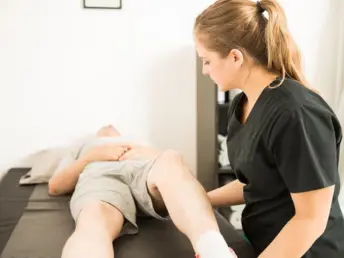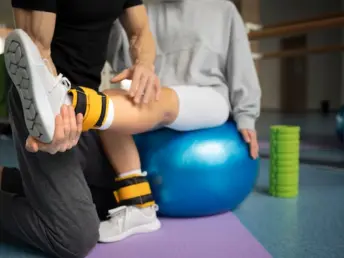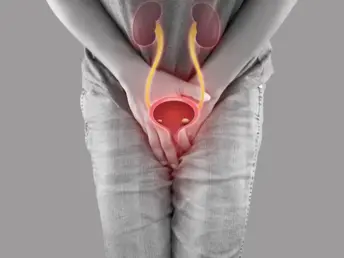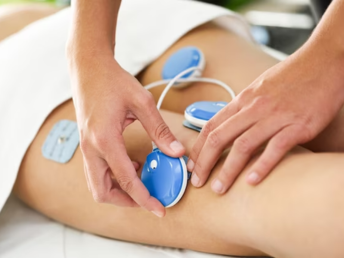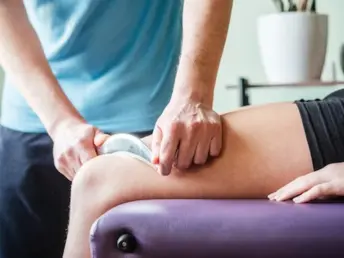Services
Thank you for considering our physiotherapy services. Whether you’re seeking treatment for a neurological condition, musculoskeletal issue, sports injury, or pediatric care, we’re here to help you achieve your optimal physical well-being.
Our Huge Selection of Services
At Arun’s NewLife Physio Clinic, our expertise is rooted in a passion for delivering unparalleled physiotherapy care. Our team of dedicated and experienced physiotherapists is committed to guiding you on your journey to optimal health and well-being.
01. Neurological Physiotherapy
Depending on the particular requirements of each patient with a goal-oriented purpose, neurological physiotherapy is a specialized area of physiotherapy devoted to enhancing the patient’s function and aiding in the rehabilitation of physical disability caused by neurological diseases.
- Stroke Rehabilitation
- Parkinson’s Disease Management
- Treatment for Hemiplegia, Paraplegia, Monoplegia
- Guillain-Barré Syndrome (GBS)
- Multiple Sclerosis
- Bell’s Palsy
- Peripheral Nerve Injury Rehabilitation
02. Orthopedic Physiotherapy
The treatment of injuries or illnesses affecting the musculoskeletal system—which is made up of joints, muscles, bones, ligaments, tendons, and connective tissue—is the focus of this area of physiotherapy.
Orthopedic physical therapy can be utilized for the following conditions:
- Osteoarthritis Management
- Rheumatoid Arthritis Care
- Osteoporosis Programs
- Scoliosis Treatment
- Ankylosing Spondylitis Support
- Ligament Sprain, Strain, or Tear Rehabilitation
- Joint Pain and Stiffness Management
03. Sports Injury and Rehabilitation:
A kind of physical therapy known as sports injury and rehabilitation treats patients of all ages who suffer from injuries related to sports. The main goals of this type of care are to meet the needs of the athlete by helping them heal from their injuries, restore their capacity and range of motion, maintain their health and fitness, resume their participation in sports after an injury, and reduce their risk of getting hurt again.
- Sports-Specific Injury Treatment
- Rehabilitation for Athletes
- Strength and Conditioning Programs
- Injury Prevention Strategies
- Return-to-Sport Protocols
04. Pediatric Physical Therapy
Pediatric physical therapy is a specialty of physical therapy that treats and manages acquired and genetic injuries in children and infants. The primary goal is to assist kids in reaching their full potential in terms of both physical development and functional independence so that parents can enjoy happy, fulfilling lives with their kids.
- Developmental Assessments
- Congenital and Acquired Injury Management
- Motor Skill Development
- Pediatric Orthopedic Care
- Support for Developmental Disorders
05. Geriatric Physical Therapy & Rehabilitation
A type of physical treatment called geriatric physical therapy is designed especially with older persons and their problems in mind. Elderly people lose muscle strength and coordination as a result of becoming less active over time. Its primary goals are to increase strength and stamina, lower the risk of falls, and maintain independence when carrying out daily tasks.
At our clinic, we offer special care for seniors to help them stay active and healthy. Our services are designed to:
- Improve Movement: We work on making it easier for seniors to move comfortably.
- Boost Independence: Our focus is on helping seniors do things on their own, promoting independence.
- Manage Pain: If there’s any pain or discomfort, we help in managing and reducing it.
- Prevent Falls: We provide exercises to improve balance and stability, reducing the risk of falls.
- Recover from Injuries: For those recovering from injuries, we offer gentle therapies to speed up recovery.
- Enhance Overall Well-Being: Our goal is to improve the overall well-being of our seniors, ensuring a happy and healthy lifestyle.
06. Electrotherapy In Physical Therapy
A variety of treatments known as “electrotherapy” use electricity to treat a variety of conditions. It has been shown to directly block the transmission of pain signals along nerves and to encourage the release of endorphins, which are the body’s natural painkillers that improve circulation, reduce pain, strengthen muscles, repair tissue, and encourage bone growth.
Pain Relief: Say goodbye to discomfort as Electrotherapy blocks pain signals along nerves.
Endorphin Boost: Experience a surge of natural painkillers, promoting a sense of well-being.
Improved Circulation: Enhance blood flow for better nutrient delivery and waste removal.
Tissue Repair: Stimulate the healing of tissues, fostering recovery from injuries.
Muscle Strengthening: Activate and strengthen muscles, aiding in overall physical resilience.
Bone Growth: Promote bone health and growth, crucial for maintaining mobility.
07. Urinary Incontinence
Easily losing pee is known as urinary incontinence. Treatment options for urinary incontinence include surgery, electrical stimulation, bladder training, and pelvic floor muscle training.
Pelvic floor physiotherapy is useful for leakage issues resulting from increased abdominal pressure. Enhancing bladder control by fortifying the muscles supporting the bladder and urethra is possible through pelvic floor exercises.
- Lifestyle Tips: We provide easy-to-follow advice on habits that can positively impact bladder health.
- Bladder Training: Learn techniques to better control your bladder through strategic scheduling.
- Pelvic Floor Exercises: Simple exercises to strengthen the muscles supporting your bladder, promoting better control.
- Innovative Therapies: Explore modern approaches like electrical stimulation to enhance muscle function.
- Personalized Care: If needed, we discuss surgical options, always with your unique needs in mind.
08. Dry Needling Therapy
By releasing trigger points, dry needling is an invasive therapy used only to treat musculoskeletal and neuromuscular pain. Inserting a small filiform needle into the trigger point inserting a small filiform needle into the trigger point, you can release natural pain relievers, relax the muscle, increase blood flow, reduce inflammation, and initiate a healing response. To maximize its healing effects, electrical stimulation is frequently used with it.
Targeted Pain Relief: Precise needling directly addresses musculoskeletal and neuromuscular pain.
Natural Healing: Release your body’s natural pain relievers for effective and gentle relief.
Muscle Relaxation: Experience tension release as muscles naturally relax during the therapy.
Enhanced Blood Flow: Improve blood circulation to encourage quicker healing.
Inflammation Control: Address swelling and discomfort by directly targeting inflammation.
Accelerated Healing: Initiate your body’s natural healing response for faster recovery.
Electrically Boosted: To maximize benefits, we often pair dry needling with electrical stimulation for added healing power.
09. Kinesio Taping
Kinesio taping is a rehabilitation technique used by the body to relieve discomfort, reduce swelling, and enhance functionality. It helps the body’s natural healing process by supporting and stabilizing muscles and joints without limiting their range of motion. The procedure applies Kinesiology tape strips to the body in exact orientation for therapeutic effects.
- Natural Healing Assistance: We use specialized tape to support your body’s natural healing.
- Muscle and Joint Support: Experience stability without limiting your body’s movement.
- Pain Comfort: Reduce discomfort by applying tape strategically to ease pain.
- Swelling Management: Targeted taping helps manage and reduce swelling effectively.
- Enhanced Functionality: Improve your body’s function with our purposeful taping techniques.
10. Exercise Therapy
A method or schedule of physical exercises created and prescribed to help an individual recover from diseases or injuries is known as exercise therapy. Exercises are done to restore normal musculoskeletal function or to lessen pain from illnesses or accidents. They are also done to maintain a state of well-being and to achieve specific health goals and activities of daily life.
11. Women`s Health
Physiotherapy is essential for women’s health since it can help with a wide range of problems, including lymphoma, pelvic pain, osteoporosis, incontinence, pregnancy and postpartum musculoskeletal discomfort, education, prevention, wellness, and exercise, among many other things. Physical therapy is beneficial for women of all ages, including young athletes, expectant mothers, menopausal women, and elderly women. Physiotherapy promotes optimal function, pain relief, and an enhanced quality of life by tailoring specific treatments and exercises to the unique needs of women.
12. Cardio Pulmonary Physiotherapy
The field of physiotherapy known as cardio-pulmonary physiotherapy focuses on the management, prevention, treatment, and rehabilitation of patients with heart and lung conditions and accidents.
Assist the person in overcoming limitations on their activities, contribution, and physical and functional abilities due to the damage to their heart, lungs, and blood vessels.
13. IASTM (Instrument assisted soft tissue mobilization )
A skilled myofascial intervention known as “instrument-assisted soft tissue mobilization” (IASTM) is used to treat soft tissues. The instruments used in this type of treatment are typically made of stainless steel with sharp edges and contours that can conform to various anatomical locations and allow for deeper penetration. This helps to break down fascial restrictions and scar tissue effectively while rapidly restoring normal soft tissue texture, flexibility, and function.
14. Joint Mobilization& Manipulations
Physiotherapists often use mobilizations and manipulations to treat aching and restricted joints. Repetitive, mild motion is used in mobilization, and it can help lower discomfort, enhance joint function, and expand the range of motion surrounding the joint.
A single, quick, forceful application of pressure to a joint that is at the limit of its range of motion is manipulation. It may have an immediate impact on joint motion, easing your discomfort. There may be a slight release of endorphins and a decrease in joint stiffness after manipulation.
15. Post Operative Physical therapy Rehabilitation
For several treatments such as orthopedic, cardiac, thoracic, neurological, and abdominal surgeries, postoperative rehabilitation may be required. Through specialized sessions and exercises, post-operative physical therapy aims to restore lost movement in the body after surgery. This allows patients to regain muscle strength and movement, enabling them to perform daily tasks as soon as possible. Finally, the goal is to help patients recover and resume their normal physical activities.
Pre-surgery rehabilitation enables patients to safely recover from surgery and get ready for it under a physical therapist’s supervision. Before surgery, physical activity improves physical health and reduces stays
16. Physical Therapy in Choric Renal Diseases
A chronic illness that can have a detrimental impact on musculoskeletal health is chronic kidney disease (CKD). Hunger, bone disease, and a loss in body fat are examples of these diseases. In addition to promoting a healthy lifestyle, regular personalized exercise therapy can lower the incidence of CKD-related musculoskeletal and cardiovascular problems.
17. Home Care Physical Therapy
In physical therapy, home care refers to treating and caring for patients while they are at home. For physical therapy appointments, some patients find it difficult to leave the house. For individuals who are unable to visit a physiotherapy clinic, this kind of care is vital and can change their lives. When a physical therapist visits your home to provide rehabilitation services, these persons might still benefit from receiving physical treatment there.
With this type of therapy, each patient’s specific needs are met by a unique and personalized approach to treatment. Also, it lets the patients get care in a setting they are utilized to and feel comfortable with, which reduces worry and tension and speeds healing. On the first day, the physiotherapist will do a thorough initial evaluation, which will serve as the foundation for creating a personalized treatment plan. Depending on the treatment and the patient’s condition, the service can take anywhere from 45 minutes to an hour to complete.
Subsribe To Our Newsletter
Stay in touch with us to get latest news and special offers.

